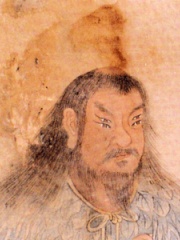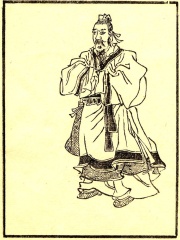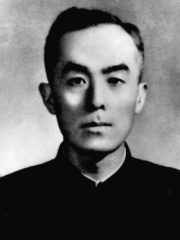




The Most Famous
HISTORIANS from China
This page contains a list of the greatest Chinese Historians. The pantheon dataset contains 561 Historians, 6 of which were born in China. This makes China the birth place of the 19th most number of Historians behind Czechia, and Syria.
Top 6
The following people are considered by Pantheon to be the most legendary Chinese Historians of all time. This list of famous Chinese Historians is sorted by HPI (Historical Popularity Index), a metric that aggregates information on a biography's online popularity.

1. Sima Qian (145 BC - 86 BC)
With an HPI of 83.52, Sima Qian is the most famous Chinese Historian. His biography has been translated into 118 different languages on wikipedia.
Sima Qian (c. 145 BC – c. 86 BC) was a Chinese historian during the early Han dynasty. He is considered the father of Chinese historiography for the Shiji (sometimes translated into English as Records of the Grand Historian), a general history of China covering more than two thousand years from the rise of the legendary Yellow Emperor and formation of the first Chinese polity to the reign of Emperor Wu of Han, during which Sima wrote. As the first universal history of the world as it was known to the ancient Chinese, the Shiji served as a model for official histories for subsequent dynasties across the Sinosphere until the 20th century. Sima Qian's father, Sima Tan, first conceived of the ambitious project of writing a complete history of China, but had completed only some preparatory sketches at the time of his death. After inheriting his father's position as court historian in the imperial court, he was determined to fulfill his father's dying wish of composing and putting together this epic work of history. However, in 99 BC, he would fall victim to the Li Ling affair for speaking out in defense of the general, who was blamed for an unsuccessful campaign against the Xiongnu. Given the choice of being executed or castrated, he chose the latter in order to finish his historical work. Although he is universally remembered for the Records, surviving works indicate that he was also a gifted poet and prose writer, and he was instrumental in the creation of the Taichu calendar, which was officially promulgated in 104 BC. Sima was acutely aware of the importance of his work to posterity and its relationship to his own personal suffering. In the postface of the Records, he implicitly compared his universal history of China to the classics of his day, the Guoyu by Zuo Qiuming, "Li Sao" by Qu Yuan, and the Art of War by Sun Bin, pointing out that their authors all suffered great personal misfortunes before their lasting monumental works could come to fruition. Sima Qian is also depicted in the Wu Shuang Pu by Jin Guliang.

2. Cangjie (b. 2650 BC)
With an HPI of 65.55, Cangjie is the 2nd most famous Chinese Historian. His biography has been translated into 24 different languages.
Cangjie is a legendary figure in Chinese mythology, said to have been an official historian of the Yellow Emperor and the inventor of Chinese characters. Legend has it that he had four eyes, and that when he invented the characters, the deities and ghosts cried and the sky rained millet. He is considered a legendary rather than historical figure, or at least not considered to be the sole inventor of Chinese characters. Cangjie was the eponym for the Cangjiepian proto-dictionary, the Cangjie method of inputting characters into a computer, and a Martian rock visited by the Mars rover Spirit, and named by the rover team.

3. Pei Songzhi (372 - 451)
With an HPI of 61.53, Pei Songzhi is the 3rd most famous Chinese Historian. His biography has been translated into 16 different languages.
Pei Songzhi (372–451), courtesy name Shiqi, was a Chinese historian and politician who lived in the late Eastern Jin dynasty and the Liu Song dynasty. His ancestral home was in Wenxi County, Shanxi, but he moved to the Jiangnan region later. He is best known for making annotations to the historical text Records of the Three Kingdoms (Sanguozhi) written by Chen Shou in the third century, providing additional details omitted from the original work. His commentary, completed in 429, became integral to later editions of the Sanguozhi, making the joint work three times as long as the original. His son, Pei Yin (裴駰), and great-grandson Pei Ziye (裴子野), were also well-known historians.

4. Guo Pu (276 - 324)
With an HPI of 61.24, Guo Pu is the 4th most famous Chinese Historian. His biography has been translated into 18 different languages.
Guo Pu (Chinese: 郭璞; AD 276–324), courtesy name Jingchun (Chinese: 景純; pinyin: Jǐngchún), was a Chinese historian, poet, and writer during the Eastern Jin period, and is best known as one of China's foremost commentators on ancient texts. Guo was a Taoist mystic, geomancer, collector of strange tales, editor of old texts, and erudite commentator. He was the first commentator of the Shan Hai Jing and so probably, with the noted Han bibliographer Liu Xin, was instrumental in preserving this valuable mythological and religious text. Guo Pu was the well-educated son of a governor. He was a natural historian and a prolific writer of the Jin dynasty. He is the author of The Book of Burial, the first-ever and the most authoritative source of feng shui doctrine and the first book to address the concept of feng shui in the history of China, making Guo Pu the first person historically to define feng shui, and therefore, Guo Pu is usually called the father of feng shui in China.

5. Zhao Rukuo (1170 - 1228)
With an HPI of 56.66, Zhao Rukuo is the 5th most famous Chinese Historian. His biography has been translated into 16 different languages.
Zhao Rukuo (simplified Chinese: 赵汝适; traditional Chinese: 趙汝适; pinyin: Zhào Rǔkuò; 1170–1231), also romanised as Zhao Rugua, Chau Ju-kua, or misread as Zhao Rushi, was a Chinese government official and writer during the Song dynasty. He wrote a two-volume book titled Zhu Fan Zhi. The book deals with the world known to the Chinese in the twelfth and thirteenth centuries; the first volume is a list of foreign places with descriptions of each place and the customs of its local people. The second volume is a catalog of trade goods.

6. Ji Xianlin (1911 - 2009)
With an HPI of 54.71, Ji Xianlin is the 6th most famous Chinese Historian. His biography has been translated into 15 different languages.
Ji Xianlin (Chinese: 季羨林; pinyin: Jì Xiànlín; August 6, 1911 – July 11, 2009) was a Chinese Indologist, linguist, paleographer, historian and writer who has been honored by the governments of both India and China. Ji was proficient in many languages including Chinese, Sanskrit, Arabic, English, German, French, Russian, Pali and Tocharian, and translated many works. He published a memoir, The Cowshed: Memories of the Chinese Cultural Revolution, about his persecution during the Cultural Revolution.
People
Pantheon has 6 people classified as Chinese historians born between 2650 BC and 1911. Of these 6, 1 (16.67%) of them are still alive today. The most famous living Chinese historians include Cangjie. The most famous deceased Chinese historians include Sima Qian, Pei Songzhi, and Guo Pu.
Living Chinese Historians
Go to all RankingsDeceased Chinese Historians
Go to all RankingsSima Qian
145 BC - 86 BC
HPI: 83.52
Pei Songzhi
372 - 451
HPI: 61.53
Guo Pu
276 - 324
HPI: 61.24
Zhao Rukuo
1170 - 1228
HPI: 56.66
Ji Xianlin
1911 - 2009
HPI: 54.71

